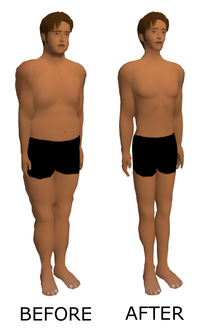
Photo from wikipedia
Adiposity rebound (AR) is defined as the second rise in the body mass index (BMI) usually occurring in early childhood. This study aimed to investigate the timing of AR and… Click to show full abstract
Adiposity rebound (AR) is defined as the second rise in the body mass index (BMI) usually occurring in early childhood. This study aimed to investigate the timing of AR and the factors determining early AR (EAR) by tracking BMI patterns using large-scale longitudinal nationwide data (n = 142,668; 73,389 boys and 69,279 girls) over seven time periods (4–6, 9–12, 18–24, 30–36, 42–48, 54–60, and 66–71 months). The average BMI rebound indicating AR was found before the age of 5 years (6th time period, 54–60 months). Interestingly, children experiencing BMI rebound during the 4th to 6th time periods showed a small increase in the proportion of underweight in the 2nd time period, but a dramatically higher proportion of underweight during the corresponding time period, similar to M-shaped patterns. In contrast, overweight or obese children in the above group showed opposite W-shaped patterns. The parameters predicting the risk of EAR are diverse for each time period by sex. Adequate breastfeeding before the age of 1 year, adequate diet, and reduced sugar-sweetened beverage consumption after the age of 1 year were important for reducing EAR. This study presents for the first time, the timing of AR and the major determinants of EAR among Korean infants and children based on large-scale nationwide data.
Journal Title: Nutrients
Year Published: 2022
Link to full text (if available)
Share on Social Media: Sign Up to like & get
recommendations!